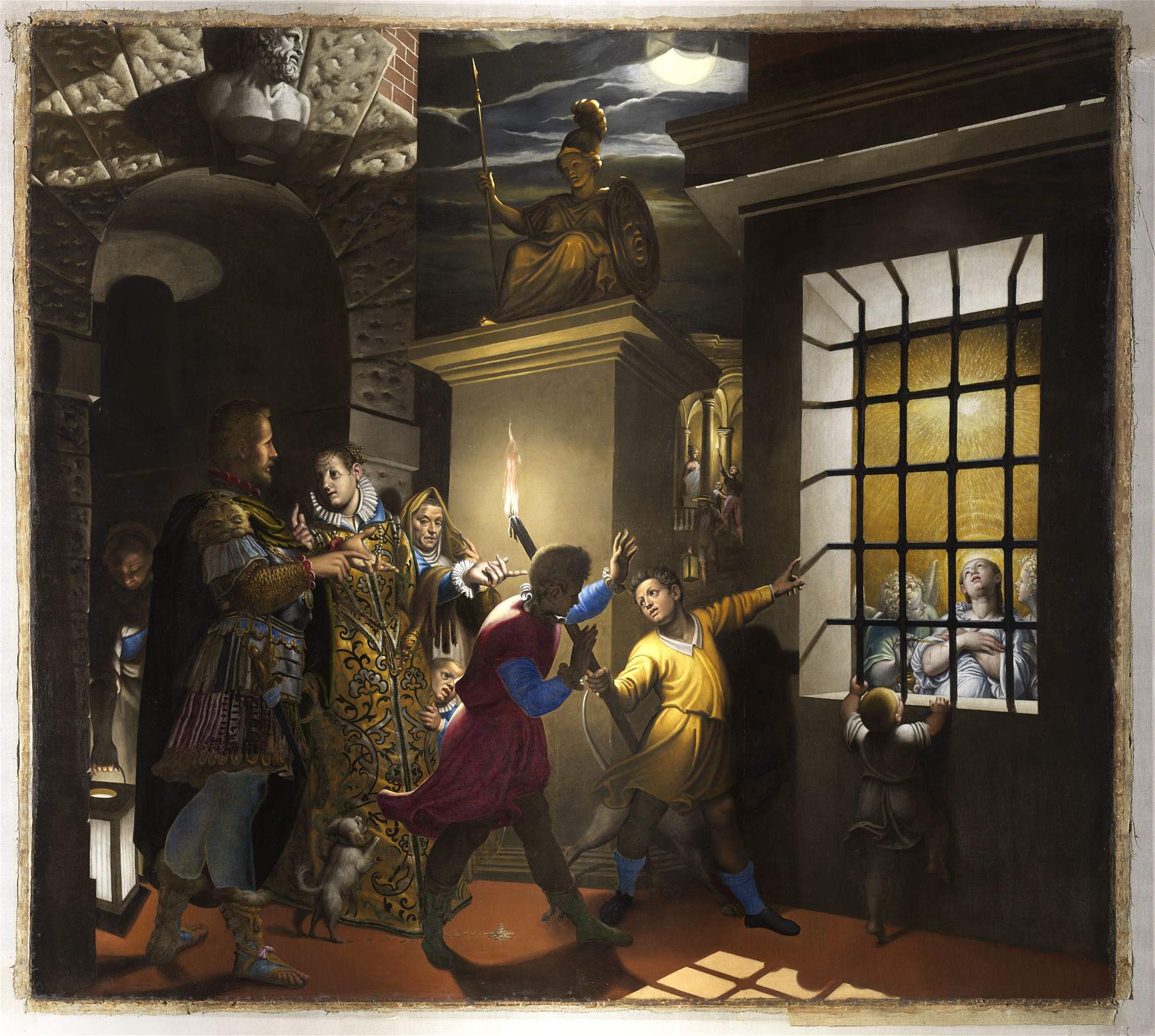An exhibition in Milan on the restoration of Antonio Campi's monumental masterpiece that inspired Caravaggio, according to Longhi
From November 30, 2018 to January 13, 2019, the Museo Diocesano “Carlo Maria Martini” in Milan is hosting the exhibition Antonio Campi. The Restoration of the Altarpiece of Santa Maria degli Angeli in Milan, which aims to present to the public the monumental masterpiece by Antonio Campi (Cremona, 1524 - 1587), depicting St. Catherine Visited in Prison by the Empress Faustina, painted in 1584, and which has just seen the completion of a major restoration work carried out at Palazzo Creberg by restorer Delfina Fagnani (Sesti Restauri) and financed by the Credito Bergamasco Foundation. The large painting, measuring four by five meters, will be displayed at the Museo Diocesano before being returned to its home, the church of Santa Maria degli Angeli in Milan.
The work was executed, along with a pendant depicting the martyrdom of the saint, to decorate the chapel of the Porzia Landi Gallarati family in Santa Maria degli Angeli: inside the chapel, moreover, there were also other works such as Gaudenzio Ferrari’s theatrical altarpiece, now at the Pinacoteca di Brera. The scene painted by Campi simultaneously depicts two different episodes from Jacopo da Varazze’s Legenda aurea: Empress Faustina’s visit to St. Catherine of Alexandria in prison, and that of the angels. The hagiography relates that the young Catherine confronted the emperor Maxentius in an attempt to convert him.Maxentius, unable on his own to respond to the saint’s arguments, had fifteen philosophers arrive in Alexandria, but Catherine succeeded in converting them. The emperor, enraged, locked her up in prison where she was miraculously healed by angelic figures. One night Faustina, wife of Maxentius, accompanied by Porphyry, captain of the guard, and his retinue, went to visit the young woman in prison. There, thunderstruck by the vision of angels surrounded by supernatural light, all the onlookers were converted to Christianity.
The Cremonese artist’s painting is distinguished by an extraordinary and innovative use of light. The nocturnal setting of the scene favors, as Raphael had already suggested in the Liberation of St. Peter frescoed in the Vatican Stanze, the introduction of three different lights: the natural one (of the moon), the artificial one (of the lamp and the flashlight) and the supernatural one (of the angels and the saint). The unification of two different episodes (the visit of the empress and, at the same time, the arrival of the angels) favors the luministic effects, which allow the slow unraveling of the complex architectural structure cleverly set up also from the perspective point of view. The glimmers of light, in fact, induce the eye to continue from the foreground to the distant loggia that can be glimpsed in the background.
The work caused such a stir among contemporaries that Paolo Lomazzo criticized it harshly in his Rime of 1587, dedicating to it a sonnet entitled Contro un pittor moderno. Of a completely different opinion was, at the beginning of the twentieth century, Roberto Longhi: “Naturalizing, phenomenizing those lights and their contrasts was the only way to lay, however roughly one wishes, the foundations of a new pictorial astonishment, the foundations of the style of macchia [...]. To Campi it now seems more meritorious to know how to overthrow to the ground, in the luminous clearing, the shadowy projection of the prison grating, than to produce in ’universal light’ some new load of academic muscle [...] multiplies the illusions of lume and controlume; of lume from above and below, but always close, oblique, sharp shaping the forms more and more daringly until the subtilty of the young bearer’s face initiating there that drowning of the contours that will be wrongly reproached to Caravaggio”(Quesiti caravaggeschi: I precedenti, 1928-29). According to Longhi, this painting in fact represented an inescapable model for Caravaggio who, precisely in 1584 entered the Milanese workshop of Simone Peterzano: “you would not find a composition, a light machine from which Caravaggio shows that he drew his proceeds more than from this one by Campi, and twice: first, very young, in the Vocation of St. Matthew, later, indeed as of late, in the Beheading of the Baptist in Malta.”
As for the restoration, Delfina Fagnani explained that, during the five months of work on the work, “preliminary scientific investigations were carried out, as is customary, from which very interesting data immediately emerged regarding the painting technique that Antonio Campi used to create this great work: the support fabric with lozenge weave, the punctual setting design, the surprisingly rich and varied palette. Data that later, during the long and repeated phases of cleaning the pictorial mantle (the last restoration dates back to a century ago), were directly reflected both in the general recovery of a still strongly sixteenth-century color scheme, and in the remarkable modernity of the pictorial renditions of every single and precise detail that Antonio Campi researches and enhances with determined attention and an amused playfulness.”
The exhibition can be visited during the opening hours of the Diocesan Museum of Milan: Tuesday through Sunday from 10 a.m. to 6 p.m. Closed Mondays (except holidays), last admission at 5:30 p.m. Tickets: full 8 euros, reduced groups 6 euros, reduced schools and oratories 4 euros. For info: www.museodiocesano.it.
Pictured: Antonio Campi, Saint Catherine Visited in Prison by Empress Faustina (1584; oil on canvas, 400 x 500; Milan, church of santa Maria degli Angeli)
 |
| An exhibition in Milan on the restoration of Antonio Campi's monumental masterpiece that inspired Caravaggio, according to Longhi |
Warning: the translation into English of the original Italian article was created using automatic tools. We undertake to review all articles, but we do not guarantee the total absence of inaccuracies in the translation due to the program. You can find the original by clicking on the ITA button. If you find any mistake,please contact us.





























